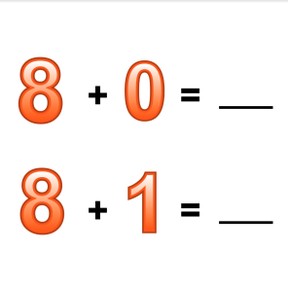
Addition to 10 with one more, one less
I can add up to 10 with one more or one less.



8,000 schools use Gynzy
92,000 teachers use Gynzy
1,600,000 students use Gynzy
General
Students learn to add to 10 in which they add one more, or one less.
Standards
K.OA.A.2
Introduction
Hand out number cards from 1 to 10 to the students. Every student has a number card. As a class, count from 1 to 10. When the students hear the number that is on their number card, they must stand up. Next start counting from the number 4. Have the students exchange number cards so they have a new number card. Write a number on the interactive whiteboard. If a student's number card is one before or one after the number you wrote down. Repeat this with all the numbers.
Instruction
Ask five students to come to the front of the class. Split them into a group of 3 and a group of 2. Ask the students in class how many there are in total. Then ask another student to come to the front and add them to the group of two. How many students are there now? Repeat this with different divisions, making answers that are always one more or one less. Next show the balloons on the interactive whiteboard. Say that you have one balloon, and one more is added. Together there are two. Discuss the other addition problems with balloons with the students. Ask the students if they notice anything about the problems. Say that one balloon is added every time. Sometimes you don't have visual support for your addition problem, you only have numbers. Compare the two addition problems. If the first number is one more than the first number in the second problem, and the second numbers stay the same, then the total of the problem will also be one more. Show the addition problems on the interactive whiteboard and ask students to find the totals. Ask how they figured out what the answers to the second and third problems were as well. Did they add the numbers together again, or did they add one more? Tell students that when the second number in the second problem is one more than the first problem, that the answer is one less. Practice with the given problems.
Show students the balloons on the interactive whiteboard, and say that there are three, and four more are added. Together there are 7 balloons. Discuss the other problems with the balloons. Ask students if they notice anything about the problems. Say that you take one balloon away every time. Sometimes you don't have visual support for your addition problem, you only have numbers. Compare the problems. If the first number is one less in the second problem, the answer is also one less in the second problem. Show the students the problems on the interactive whiteboard and have students solve for the answer. Say that when the second number in the second problem is one less than in the first problem, that the answer is also one less. Practice with more problems. Next show some problems on the interactive whiteboard and have students find the answers. Ask them to write their answers down, and hold them up to check.
To check that students understand adding to 10 with one more and one less you can ask them the following questions/give the following exercises:
- What do you look at to know if you need to count one more or one less?
- Calculate: 5+3= and 5+4
- Calculate: 7+2= and 6+2
Quiz
Students first practice adding one more or one less with a set of two problems. They then practice with a set of 3 problems.
Closing
Discuss with students that it is important to be able to add to 10 with one more and one less, so you can quickly solve sets of problems without needing to calculate each one separately. Show some problems on the interactive whiteboard and ask students if they can calculate them without doing each problem separately. Ask students how they got their answers and if there are any ways to do the problems in an easier or faster way, or if they solved each problem separately. Ask students to work in pairs. One student writes down a math problem. The second student writes a similar problem, with one more or one less. They solve the problems together.
Teaching tips
Students who have difficulty adding with one more and one less can make use of manipulatives like MAB blocks. Have them set out blocks or manipulatives to represent the math problems and then add one block or take one away.
Instruction materials
Number cards to 10, MAB blocks or other manipulatives
The online teaching platform for interactive whiteboards and displays in schools
Save time building lessons
Manage the classroom more efficiently
Increase student engagement
Discover more!
About Gynzy
Gynzy is an online teaching platform for interactive whiteboards and displays in schools.
With a focus on elementary education, Gynzy’s Whiteboard, digital tools, and activities make it easy for teachers to save time building lessons, increase student engagement, and make classroom management more efficient.



